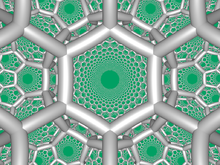三阶六边形镶嵌蜂巢体
在双曲几何学中,三阶六边形镶嵌蜂巢体是一种完全填满仿紧双曲空间的几何结构,是十一种三维仿紧正双曲密铺之一[1],由正六边形镶嵌的胞组成。由于其胞为一种无限面体,因此该几何结构为仿紧空间。
| 三阶六边形镶嵌蜂巢体 | |
|---|---|
 | |
| 类型 | 双曲正堆砌 |
| 家族 | 堆砌 |
| 维度 | 三维双曲空间 |
| 对偶多胞形 | 六阶四面体堆砌 |
| 数学表示法 | |
| 考克斯特符号 | |
| 施莱夫利符号 | {6,3,3} t{3,6,3} 2t{6,3,6} 2t{6,3[3]} t{3[3,3]} |
| 性质 | |
| 胞 | {6,3}  |
| 面 | {6} |
| 组成与布局 | |
| 顶点图 | {3,3} |
| 对称性 | |
| 对称群 | , [6,3,3] , [3,6,3] , [6,3,6] , [6,3[3]] , [3[3,3]] |
| 特性 | |
| 正 | |
性质
三阶六边形镶嵌蜂巢体由无限多个正六边形镶嵌胞组成,每个顶点都是三个正六边形镶嵌的公共顶点,每个正六边形镶嵌胞的顶点都落在双曲极限球(双曲三维极限圆)上。
三阶六边形镶嵌蜂巢体在施莱夫利符号计为 {6,3,3} ,其中 {6,3} 正六边形镶嵌,加一个3表示每条棱都是三个正六边形镶嵌的公共边。其顶点图为 {3,3} 正四面体[3]。
图像
这个图像是一个三阶六边形镶嵌蜂巢体庞加莱模型的外视角,其显示了蜂巢体中的一个六边形镶嵌胞,其半径与极限球相同。在这个投影图上,无限延伸的六边形朝向一个理想点不断趋近。
| {6,3,3} | {∞,3} |
|---|---|
| 蜂巢体中的其中一个六边形镶嵌胞 | 三阶无限边形镶嵌中的无限边形(绿色)及其外接圆极限圆。 |
相关多胞体与堆砌
三阶六边形镶嵌蜂巢体是十一种三维仿紧正双曲密铺之一,其他十种三维仿紧正双曲密铺为:
| 十一种三维仿紧正双曲密铺 | |||||||||||
|---|---|---|---|---|---|---|---|---|---|---|---|
| {6,3,3} (镶嵌蜂巢体) |
{6,3,4} (镶嵌蜂巢体) |
{6,3,5} (镶嵌蜂巢体) |
{6,3,6} (镶嵌蜂巢体) |
{4,4,3} (镶嵌蜂巢体) |
{4,4,4} (镶嵌蜂巢体) | ||||||
| {3,3,6} (多面体堆砌) |
{4,3,6} (多面体堆砌) |
{5,3,6} (多面体堆砌) |
{3,6,3} (镶嵌蜂巢体) |
{3,4,4} (镶嵌蜂巢体) | |||||||




